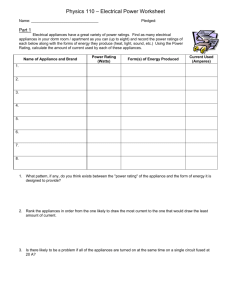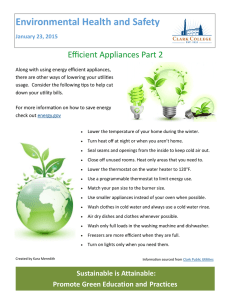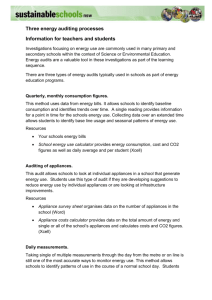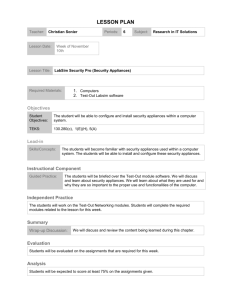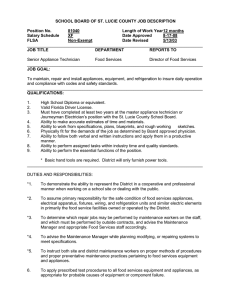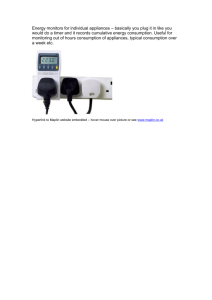Sustainable Purchasing Guide Small Appliances
advertisement
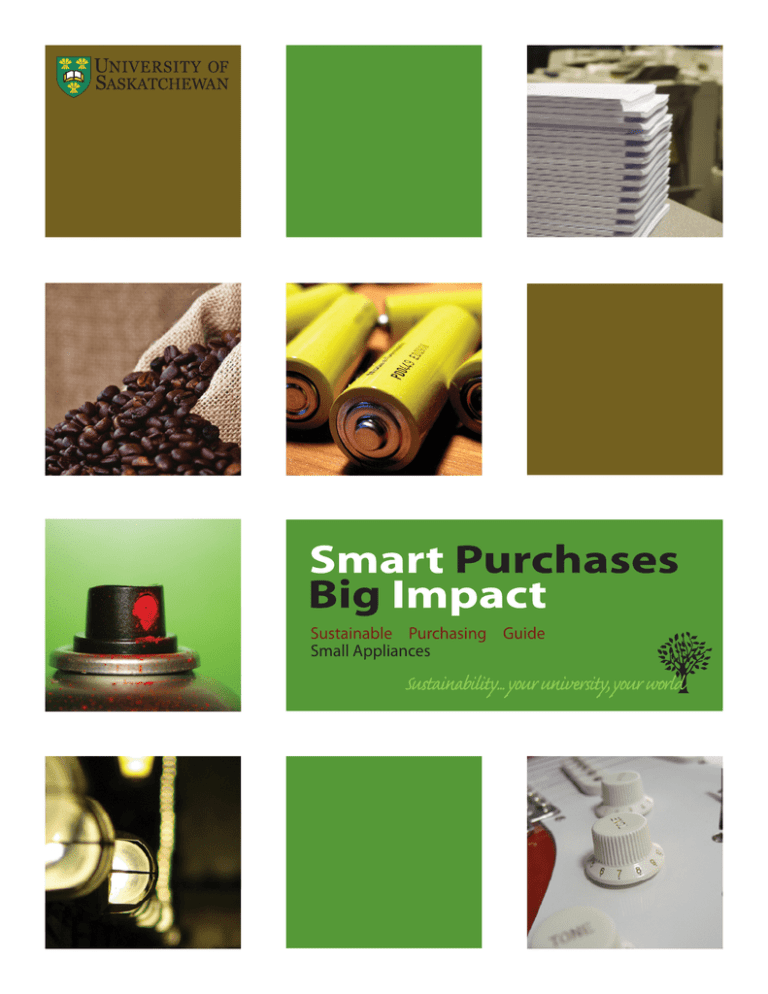
Sustainable Purchasing Guide Small Appliances Small Appliances Introduction This section provides information on currently available small appliance options that can help to move the University of Saskatchewan toward its sustainability goals. Living within the boundaries of our sustainability objectives requires us to apply two main strategies: Dematerialization requires that we reduce the amount of materials as much as possible; and that we continually move toward the use of 100% recycled content. Substitution requires that we find less harmful materials to replace those that currently damage and are not recyclable. Sustainable purchasing is about including social, environmental, financial and performance factors in a systematic way. It involves thinking about the reasons for using the product (the service) and assessing how these services could be best met. If a product is needed, sustainable purchasing involves considering how products are made, what they are made of, where they come from and how they will be used and disposed. Finally, remember that this is an evolving document – it will change with new information as our understanding of sustainability impacts and potential solutions improves. Purchasing Services Tel: Email: (306) 966-6704 purchasing.services@usask.ca Office of Sustainability Tel: Email: (306) 966-1236 fmdsustainability@usask.ca Wherever possible CHOOSE products that employ a combination of characteristics listed in the left hand column, and AVOID products that demonstrate characteristic in the right-hand column. CHOOSE AVOID • Durable appliances • Appliances with low phantom power loss • Devices to reduce phantom power loss • Recycled and recyclable content • Appliances with a large amount of plastic components • Phantom power loss Option: Choose durability to reduce appliance waste Strategy: Substitution – Durability (SO 1, 3) Using appliances for as long as possible conserves the energy and raw materials required in manufacturing new products, moving us towards SO2. Waste is also reduced reducing the harmful effects of their final disposal in the environment. Check Consumer Reports to assess the average life-spans of comparable appliances and to determine if they can be easily and economically serviced and maintained. Look to increase energy efficiency of the small appliance by minimizing excess “frills” such as soft touch-pads and clocks that consume unnecessary energy. Regular maintenance and cleaning will prolong the life of your appliances, such as regularly removing bread crumbs in toasters, ensuring cords and plugs are intact and removing dust regularly from all systems of air exchange. Option: Avoid and reduce phantom power consumption Strategy: Substitution – Energy Efficiency (SO 1) The term “phantom power” or “leaking power” describes electrical power consumed by household gadgets and home electronics when they left are plugged into a wall outlet while the product is not in use. According to The U.S. Department of Energy, 75% of power used by small appliances is consumed while the appliance is not even turned on. There are a few simple methods of determining if your appliance is leaking energy: • It gets power from a power supply converter • It has a remote control • It has a soft touch keypad • It has a digital clock • It charges the battery of a portable device • It is warm to touch • It doesn’t have an “off” switch Learn how much phantom power a piece of equipment uses before purchasing. In the Resources section below there is a link to the Federal Energy Management Program’s (FEMP) standby power data search utility, which provides information for different appliances. Phantom power losses can be further avoid by establishing mechanisms whereby power is regularly cut to the appliance by unplugging it or plugging it into a power strip with a switch. Some power strips are available with special feature such as on/off timers or special plugs within the power bar that won’t cut the power to certain appliances that need to be left on. Aggressively combating phantom power can result in a 7-10% decrease in energy consumption each month. Sustainable Purchasing Guide Option: Choose recycled and recyclable content • Residual materials (“shredder fluff”containing plastics, foam, rubber and so on) are sent to landfill. Strategy: Substitution – Energy Efficiency (SO 1) Choose products that are manufactured using recycled content. If this is not possible, choose products containing materials that have high end-of-life value with more metal and less plastic parts. These are more easily recycled and provide a value incentive for the producer to reclaim used products and incorporate recycling in its manufacturing process. An appliance generally follows these steps when it is recycled: • Toxic and hazardous substances (including CFCs and PCBs) are removed and reclaimed or disposed • Appliances are shredded; • Magnets capture the steel, which is collected and sold to steel mills; • Other metals are separated using eddy currents. These metals are also re-sold for reprocessing The shredding process is a highly efficient process resulting in almost 100% recovery of metals, including aluminum, copper, brass, zinc and steel. Of these metals, aluminum, copper and brass are by far the most valuable, with steel having the least value. Integral to the effectiveness of this option is the need to secure a mechanism whereby the products can actually be recycled, whether through the manufacturer or through local programs. Option: Choose products that are shipped sustainably Please refer to the Sustainable Transportation Guide. Arriving at the currently preferred options 1. Identify the service 4. Identify sustainability impacts Small appliances provide efficiencies in daily activities. i. 2. Assess the need The University of Saskatchewan requires small appliances in residences, offices, labs and other facilities. 3. Identify the contents The most common material found in most small appliances (by weight) is steel, which is easily recycled. The plastics content of appliances is increasing and therefore more plastics are entering the waste stream as a result of appliance disposal. Many appliances also contain small amounts of aluminum and copper. There are often some glass components but the glass is usually treated so it is resistant to heat. This is done by mixing some form of a heavy metal with the glass which reduces its recyclability. Some lead, PCBs and other potentially harmful materials are usually found in trace amounts as well. …systematically increasing concentrations of substances from the earth’s crust? • Small appliances use electricity to operate. If the electricity used to operate the device and equipment is derived from the combustion of fossil fuels, it leads to an increase in concentration of substances from the earth’s crust in nature (CO2, CO and SOx). Increasing concentrations of these substances in nature can contribute to a number of negative outcomes such as climate change and acid rain as well as negative human health impacts. In Saskatchewan, most electrical energy is generated from the combustion of coal, a fossil fuel. • The petroleum or natural gas used as feedstock for most plastics is extracted from the earth’s crust at a rate much greater than it is re-deposited back into the earth’s crust. • Fossil fuels are also combusted to provide energy during the extraction of raw materials, transportation and the production of large appliances. continued on page 3 … Sustainable Purchasing Guide 2 ii. …systematically increasing concentrations of substances produced by society? • If the plastic used in small appliances is not recyclable, it usually ends up in landfills or incinerators. The plastic persists in the environment after it is used and discarded, contributing to an increase in concentration of complex human-made substances in nature. While it is true that over time and under the right conditions plastics will oxidize, fragment and disintegrate – with continued strong growth in the use and disposal of plastics, the timeline is too long to prevent their accumulation in nature. • The combustion of fossil fuels (see above) produces a number of chemical compounds (e.g. nitrogen oxides) that build up in the atmosphere. 6. Identify and prioritize alternatives To identify the best options, review the Current Options on page one and choose the most appropriate alternative by using the following three criteria for assessment: a)Does the product or service move us in the right direction with regards to our four Sustainability Objectives? b)Does the product or service create a flexible platform for the next step toward sustainability? c)Is the decision financially viable? iii. …systematically degrading nature by physical means? • The extraction of fossil fuels and virgin metals/minerals may systematically degrade nature, particularly where mining disturbs land that is not reclaimed and restored. iv. …systematically undermining people’s ability to meet their basic human needs? • A number of the compounds produced by the combustion of fossil fuels (e.g. nitrogen oxides, carbon monoxide, sulfur oxides, particulate matter) have a negative effect on human health. • Millions of small appliances are sent to the landfills each year displacing humans, ecosystems and natural resources. 5. Envision sustainable small appliances In principle, sustainable small appliances would feature: • no components that are derived from the earth’s crust (e.g. petrochemicals and metals), unless those ingredients are 100% captured and reused. • no components that are persistent in nature (eg. plastic), unless those substances are 100% captured and reused. • a production process that: - does not contribute to the increased concentrations of substances from the earth’s crust or the buildup of persistent compounds in nature, - uses only sustainable renewable energy or energy produced in a carbon-neutral manner; - does not rely on practices that systematically physically degrade land and ecosystems; and - does not rely on practices that undermine people’s capacity to meet their basic needs. Resources and Additional Information 1. EcoOffice Energy Saving Appliance. www.ecooffice.com.sg/templates/madeyourweb/pdf/ ecooffice01_proc_guide.pdf 2. Rutgers Purchasing Guide. www,purchasing.rutgers.edu/green/images/ Rutgers%20Green%20Purchasing%20Policy.pdf 3. Reducing Phantom Power. www.ehow.com/ how_4781905_reduce-phantom-power.html 4. Energy Saving for Home Appliances. www.energysavers.gov/your_home/appliances/index. cfm/mytopic=10060 This guide was made possible through the generosity of the Whistler 2012 project, which shared its template and much of its research. Sustainable Purchasing Guide 3

